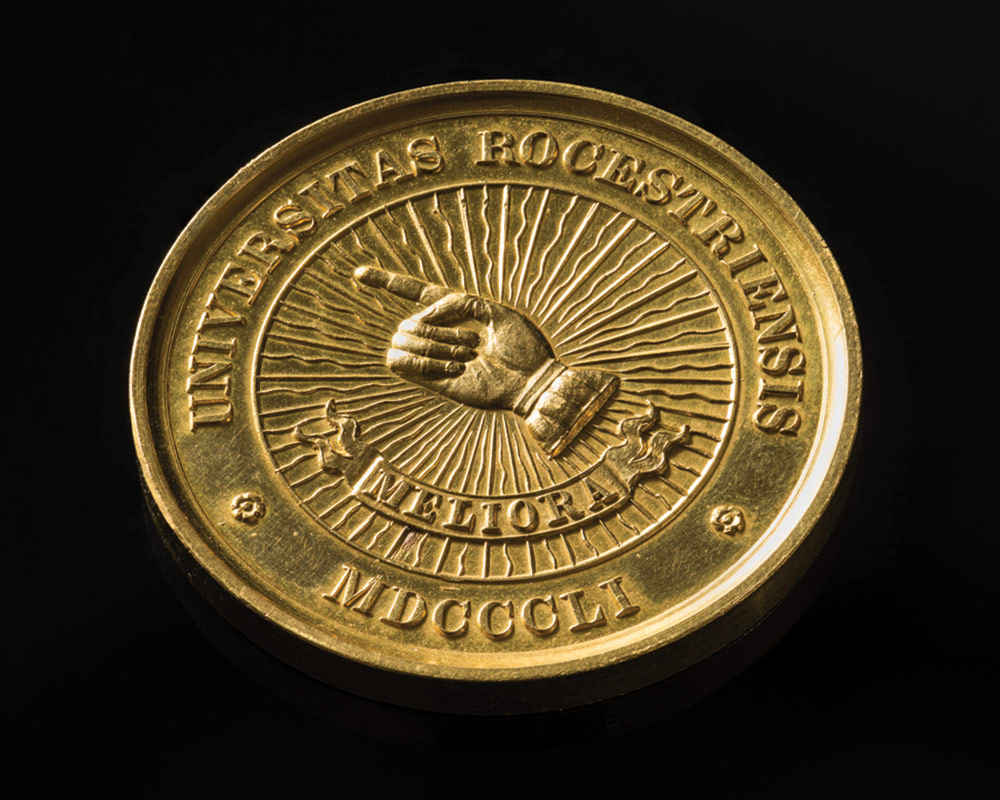Ask the Archivist
 POINTED QUESTION: Changed to “1850” early in the 20th century, the date on the University’s original seal—depicted as “1851” in Roman numerals—referred to the year that the institution was officially incorporated, rather than the year of the University’s founding. (Photograph: University Libraries/Department of Rare Books, Special Collections, and Preservation)
POINTED QUESTION: Changed to “1850” early in the 20th century, the date on the University’s original seal—depicted as “1851” in Roman numerals—referred to the year that the institution was officially incorporated, rather than the year of the University’s founding. (Photograph: University Libraries/Department of Rare Books, Special Collections, and Preservation)Need History?
Do you have a question about University history? Email it to rochrev@rochester.edu. Please put “Ask the Archivist“ in the subject line.
The first edition of Rochester Review, depicted on the cover of the Fall 2022 issue, displays the Roman numerals MDCCCLI, or 1851. Since the U of R was founded in 1850, shouldn’t the Roman numerals have been MDCCCL? I would be gratified if you would clarify this!—Ronald Kass ’68, Oyster Bay, New York
While we have been led (and sometimes led ourselves) to believe that the 1851 date on the original seal might have been an error, the Minutes of the Executive Board of Trustees meeting of April 9, 1852, specifically state the text to be used:
Universitas Rocestriensis
Meliora
MDCCCLI
Accepting the date as intentional, rather than accidental, we can follow a timeline of documents and decisions to understand why.
The University received its provisional charter from the regents of the University of the State of New York on January 31, 1850. The text states that when the proposed Board of Trustees had fulfilled certain requirements—including raising and investing funds, and equipping a suitable building—“then . . . the said Institution shall thereupon be incorporated by us, the said Regents . . . .”
The formal charter was issued February 14, 1851, and it declared that the trustees “shall be a body corporate and politic by the name of the University of Rochester and said corporation is by these presents invested with all the privileges and powers conceded to any College in this State . . . .”
Two weeks after the charter was granted, the executive board of trustees appointed a committee to “procure a corporate seal for the University.”
Time was of the essence, as a seal was needed for a mortgage to purchase our first home, the United States Hotel on West Main Street. It was decided that an image of “Lady Liberty” from the United States half-dollar coin would suffice until a permanent seal was created.
No motto or date are visible on this temporary seal, and only a few examples are found in the Archives.
There was ample time between this use of a seal and the next event when the seal would be featured: the University’s first Commencement on July 9, 1851.
The faculty meeting minutes of May 15, 1851, record: “Resolved to recommend to the Board the adoption of the word “Meliora” as the motto for the seal of the University. The device to be a hand pointing forward and upward.”
The choice of Meliora—with its possible origin in Ovid’s Latin poem “Metamorphoses”—is generally credited to professor of Greek (and interim University president) Asahel Clark Kendrick. But all the faculty were present at that meeting, including Latin professor John Fram Richardson, who was charged with composing the all-Latin text of the diplomas.
Why the emblem of a hand? No records have yet been found to inform later generations, but it bears a strong resemblance to the symbol chosen in 1776 by the founders of Phi Beta Kappa. Of the eight original faculty of the University, four were members of that honor society, as were several trustees.
The Albany firm of Gavit and Company was hired to create the diplomas for the class of 1851 and the seal. The total cost was $98, which included engraving the printing plate for the diploma text, printing the 11 parchment diplomas, and making the die for the seal. No examples of the 1851 diploma are held in the Archives.
The deliberate choice by the trustees of the 1851 date on the seal can therefore be connected to the year of the University’s incorporation, rather than its founding.
In his report to the Board of Trustees for 1929, President Rush Rhees noted: “In order to have a seal which will recognize the larger development of the University and to correct a misimpression naturally derived from the date 1851 on our old seal, a new design has been made for us by Mr. Philipp Merz of the staff of the University architects . . . .”
The new seal, with arts and sciences, music, and medicine represented, appeared for the first time on the cover of the December 1928–January 1929 issue of Review.
View examples of the seal and learn about subsequent alterations.

